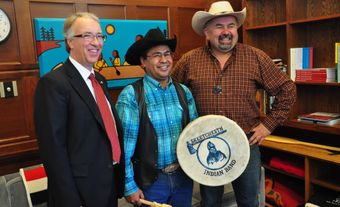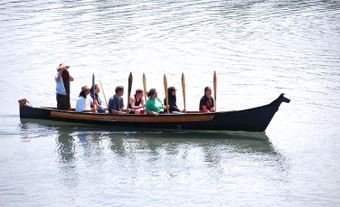The Nuxalk are an Indigenous people in Canada. Their traditional territories are in and around Bella Coola, British Columbia. The term "Bella Coola" once referred collectively to the Nuxalk, Talio, Kimsquit and some Kwatna who inhabited villages around North Bentinck Arm and the Bella Coola Valley, South Bentinck Arm, Dean Channel and Kwatna Inlet. Since the late 1970s, the Nuxalk have called themselves the Nuxalk Nation, derived from the term that in earlier times referred exclusively to the people of the Bella Coola Valley. In 2020, the Government of Canada reported the registered population of Nuxalk was 1,786, with 912 people living on reserve. (See also First Nations and Northwest Coast Indigenous Peoples in Canada.)
Traditional Territory
Nuxalk territory is in and around Bella Coola, British Columbia. By the 1920s, the Nuxalk — who had once enjoyed vast territories — were forced to come together at the village of Q’umk’uts’ (Komkotes), located at the mouth of the Bella Coola River. The Nuxalk have seven reserves total, measuring about 2,025 ha. According to the Nuxalk Nation, their reserves account for only 0.1% of their traditional territory. (See also Indigenous Territory.)
Population
In 1996, the registered Nuxalk population was 1,185, with 706 people living on the reserve. By 2021, the registered population had increased to 1,786, with 912 on reserve.
Language
The Nuxalk speak a Coast Salish language known as Nuxalk or Bella Coola. The language is isolated from other Coast Salish languages and it is distinct from the surrounding Dene and Wakashan languages. Culturally, the Nuxalk are most similar to their Wakashan neighbours, the Heiltsuk (Bella Bella).
The Nuxalk language is considered endangered as there are likely under 20 fluent speakers. However, there are more learning speakers, and language programs offered in Nuxalk communities aim to further preserve and promote the language. (See also Indigenous Languages in Canada.)
Traditional Life
Nuxalk villages traditionally consisted of descent groups who traced their lineage to a group of first ancestors. According to oral history, each group of ancestors, equipped with tools and ceremonial knowledge, descended from a mountaintop and established a village at its base.
Through marriage, a network of descent groups developed that linked the villages. Most people chose to live in their fathers' villages. However, they were also related to their mothers' descent groups, if different. The multiple-family cedar-plank dwellings were large enough to house as many as six couples and their children. (See also Plank House.) Members of the household, which included elderly relatives, supported one another in the potlatch and economic pursuits.
Culture and Society
Traditionally, the most prominent characteristic of Nuxalk life was its extremely rich and complex ceremonialism dominated by the potlatch and various secret societies, including the sisaok and thekusiut.
Membership in the sisaok was limited to the children and certain relatives of chiefs. Initiation included a period of seclusion, followed by a public display of a masked figure representing the initiate's crest. Members performed at potlatches and funerals and occasionally at less important ceremonials. Nuxalk winter ceremonials were dominated by the kusiut. Each member possessed a special kusiut name and had a supernatural patron whose dance he or she imitated.
While the potlatch was banned by the Indian Act from 1884 to 1951, it still remains an important aspect of Nuxalk culture.
History
The first recorded encounter with the Nuxalk occurred briefly in the summer of 1793 when Captain George Vancouver entered their waters. He was followed only weeks later by an overland exploration team headed by Alexander Mackenzie. This historic occasion became incorporated into Nuxalk oral tradition and the story of the welcome they gave Mackenzie is still a source of pride.
With increased white settlement on Indigenous lands, traditional ways of life for the Nuxalk, as well as for other Indigenous peoples in Canada, was forever altered. A smallpox epidemic in the 1860s decimated the Nuxalk population in many villages. Colonial programs and policies such as residential schools and the Indian Act aimed to assimilate Indigenous peoples to Euro-Canadian culture. Despite these efforts, the Nuxalk continue to preserve and promote their culture and traditional teachings.
Governance
The Nuxalk are governed by both elected and hereditary chiefs. The Indian Act outlines protocols and procedures for elected systems of band government. Hereditary systems of government are specific to Indigenous nations. In Nuxalk culture, hereditary chiefs, as well as elders and community supporters, make up the House of Smayusta (“House of Stories”). According to the Nuxalk Nation, “The House of Smayusta represents the sovereignty and traditional government of the Nuxalk.”
Contemporary Life
Historically, the Nuxalk were a fishing, hunting and gathering society. Salmon and eulachon ("candlefish") fishing in the Bella Coola River historically has been important to the Nuxalk economy. Forestry, commercial fishing and salmon-enhancement programs provide employment.
The Nuxalk operate their own school, Acwsalcta (“A Place of Learning”) as well as the Lip’alhayc Learning Centre.

 Share on Facebook
Share on Facebook Share on X
Share on X Share by Email
Share by Email Share on Google Classroom
Share on Google Classroom







